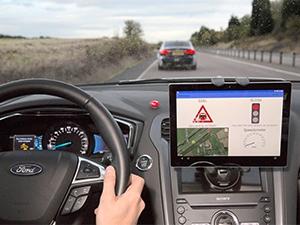
Ford is testing new technology in its cars which could help commuters skip red lights, by recommending a speed that will ensure they meet every green light.
The speed will be determined by timing information from roadside units and displayed in the car. The technology is called 'green light optimal speed advisory'.
The motoring company found daily drivers in the UK spent up to two days a year waiting at red lights. The technology will be tested on both public roads and closed circuits in Milton Keynes and Coventry in the UK over the next two years. The experiment is an effort to demonstrate the benefits of connected cars for UK Autodrive.
UK Autodrive is a partly publicly funded £20 million (R400 million) project which is developing and trialling vehicle-to-vehicle and vehicle?to?infrastructure technologies that could make driving less stressful and time-consuming, and improve fuel efficiency.
"There's not much worse after a long day than to hit one red light after another on the drive home, and be forced to stop and start again at every junction," says Christian Ress, supervisor within driver assist technologies at Ford research and advanced engineering.
"Enabling drivers to 'ride the green wave' also means a smoother, continuous journey that helps to improve the flow of traffic and provides significant reductions in carbon dioxide emissions and fuel consumption."
A screen will be in sight of the driver which will recommend a speed, and in cases where hitting a red light is unavoidable, it will display how long until the light turns green.
Similar technology is already used by cyclists in Copenhagen and Amsterdam to avoid red lights.
In the same trial, Ford will test emergency electronic brake lights. This technology gives cars warning when a vehicle up ahead suddenly brakes hard - even if the incident occurs out-of-sight - up to a distance of 500m.
This will come up on the display. Other information will include warnings when another car is blocking a junction, and when an emergency vehicle is approaching. It will also have the ability to help drivers figure out four-way stops by prioritising vehicles arriving at intersections without traffic signs or traffic lights, and letting them know when it is their time to drive.
The motoring company recently said it intends to produce high-volume fully-autonomous vehicles by 2021, and that the next decade will be defined by the automation of cars.
Ford is taking the step-by-step approach and has already incorporated some of the technology it will use in mainstream autonomous cars, into its current line-up.
Features such as adaptive cruise control to manage speed by sensing the vehicles ahead, active park assist, lane-keep assist to keep drivers from drifting across lanes, as well as pre-collision assist with head-up display which detects a potential collision and automatically applies the brakes if the driver does not respond to warnings.
The company says systems like this, and testing technologies like emergency brake lights and green light optimal speed, are the building blocks of its fully autonomous cars.
Share